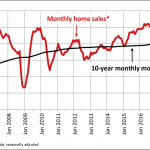Canadian home sales drop in January
Ottawa, ON, February 15, 2018 – Statistics released today by The Canadian Real Estate Association (CREA) show national home sales fell sharply in January 2018.
Highlights:
- National home sales declined by 14.5% from December 2017 to January 2018.
- Actual (not seasonally adjusted) activity was down 2.4% year-over-year (y-o-y) in January.
- The number of newly listed homes plunged 21.6% from December 2017 to January 2018.
- The MLS® Home Price Index (HPI) in January was up 7.7% y-o-y.
- The national average sale price advanced by 2.3% y-o-y.
 Home sales via Canadian MLS® Systems dropped sharply in January after having climbed to the highest monthly level on record in December. Although activity retreated to the lowest monthly level in three years, January sales were on par with the 10-year monthly average.
Home sales via Canadian MLS® Systems dropped sharply in January after having climbed to the highest monthly level on record in December. Although activity retreated to the lowest monthly level in three years, January sales were on par with the 10-year monthly average.
Activity in January was down in three-quarters of all local markets in Canada, including virtually all major urban centres. Many of the larger declines in percentage terms were posted in Greater Golden Horseshoe (GGH) markets, where sales had picked up late last year following the announcement of tighter mortgage rules coming into effect in January.
Actual (not seasonally adjusted) activity was down 2.4% from January 2017 and stood close the 10-year average for the month of January. Sales came in below year-ago levels in about half of all local markets, led by those in the GGH region. By contrast, sales were up on a y-o-y basis in the Lower Mainland of British Columbia and Vancouver Island, the Okanagan Region, Edmonton, Montreal, Greater Moncton and Halifax-Dartmouth.
“The piling on of yet more mortgage rule changes that took effect starting New Year’s Day has created homebuyer uncertainty and confusion,” said CREA President Andrew Peck. “At the same time, the changes do nothing to address government concerns about home prices that stem from an ongoing supply shortage in major markets like Vancouver and Toronto. Unless these supply shortages are addressed, concerns will persist,” he added. “A professional REALTOR® is your best source for information and guidance in negotiations to purchase or sell a home during these changing times,” said Peck.
“The decline in January sales provides clear evidence that the strength in activity late last year reflected a pull-forward of transactions, as rational homebuyers hurried to purchase before mortgage rules changed in 2018,” said Gregory Klump, CREA’s Chief Economist. “At the same time, a large decline in new listings prevented market balance from shifting in favour of homebuyers.”
The number of newly listed homes plunged 21.6% in January to reach the lowest level since the spring of 2009. New supply was down in about 85% of all local markets, led by a sizeable decline in the GTA. Large percentage declines were also recorded in the Lower Mainland of British Columbia and Vancouver Island, the Okanagan Region, Hamilton-Burlington, Oakville-Milton, Kitchener-Waterloo, London and St. Thomas, Kingston and Ottawa, closely mirroring the list of markets that saw the largest sales declines in January.
With new listings having fallen by more than sales, the national sales-to-new listings ratio tightened to 63.6% in January compared to the mid-to-high 50% range to which it held since last May.
A national sales-to-new listings ratio of between 40% and 60% is generally consistent with a balanced national housing market, with readings below and above this range indicating buyers’ and sellers’ markets respectively. That said, the balanced range can vary among local markets.
For that reason, considering the degree and duration that market balance is above or below its long-term average is a better way of gauging whether local housing market conditions favour buyers or sellers. Market balance measures that are within one standard deviation of the long-term average are generally consistent with balanced market conditions.
Based on a comparison of the sales-to-new listings ratio with its long-term average, a little over half of all local markets were in balanced market territory in January 2018. The ratio in many markets moved one standard deviation or more above its long-term average in January due to large declines in new supply.
The number of months of inventory is another important measure for the balance between housing supply and demand. It represents how long it would take to liquidate current inventories at the current rate of sales activity.
There were 5 months of inventory on a national basis at the end of January 2018, which is close to the long-term average of 5.2 months.
 The Aggregate Composite MLS® HPI rose by 7.7% y-o-y in January 2018. This was the 9th consecutive deceleration in y-o-y gains, continuing a trend that began last spring. It was also the smallest y-o-y increase since December 2015.
The Aggregate Composite MLS® HPI rose by 7.7% y-o-y in January 2018. This was the 9th consecutive deceleration in y-o-y gains, continuing a trend that began last spring. It was also the smallest y-o-y increase since December 2015.
The deceleration in y-o-y price gains largely reflects trends among GGH housing markets tracked by the index. While prices in the region have largely stabilized in recent months, ongoing deceleration in y-o-y comparisons reflects the rapid rise in prices one year ago.
Apartment units again posted the largest y-o-y price gains in January (+20.1%), followed by townhouse/row units (+12.3%), one-storey single family homes (+4.3%), and two-storey single family homes (+2.3%).
As was the case in December, Benchmark home prices in January were up from year-ago levels in 9 of the 13 markets tracked by the MLS® HPI.
Composite benchmark home prices in the Lower Mainland of British Columbia continue to trend higher after having dipped briefly during the second half of 2016 (Greater Vancouver: +16.6% y-o-y; Fraser Valley: +22.4% y-o-y). Apartment units have been driving this regional trend in recent months, with single family home prices having stabilized.
Benchmark home prices rose by about 14% on a y-o-y basis in Victoria and by about 20% elsewhere on Vancouver Island. These gains are similar to those recorded during the fourth quarter of last year.
Price gains have slowed considerably on a y-o-y basis in the GTA, Guelph and Oakville-Milton; however, home prices in the former two markets remain above year-ago levels (GTA: +5.2% y o-y; Guelph: +10.9% y-o-y; Oakville-Milton: -1.2% y-o-y). Monthly prices in these markets have shown signs of stabilizing in recent months after having climbed rapidly in early 2017 and subsequently retreated.
Calgary benchmark home prices were down slightly (-0.5% y-o-y), as were home prices in Regina and Saskatoon (-4.9% y-o-y and -4.1% y-o-y, respectively).
Benchmark home prices rose by 7.2% y-o-y in Ottawa (led by an 8.1% increase in two-storey single family home prices), by 5.2% in Greater Montreal (led by a 6.2% increase in in two-storey single family home prices) and by 7.5% in Greater Moncton (led by an 11% increase in one-storey single family home prices).
The MLS® Home Price Index (MLS® HPI) provides the best way of gauging price trends because average price trends are prone to being strongly distorted by changes in the mix of sales activity from one month to the next.
The actual (not seasonally adjusted) national average price for homes sold in January 2018 was just over $481,500, up 2.3% from one year earlier. The national average price is heavily skewed by sales in Greater Vancouver and Greater Toronto, two of Canada’s most active and expensive markets. Excluding these two markets from calculations trims $107,500 from the national average price, reducing it to $374,000.
– 30 –
PLEASE NOTE: The information contained in this news release combines both major market and national sales information from MLS® Systems from the previous month.
CREA cautions that average price information can be useful in establishing trends over time, but does not indicate actual prices in centres comprised of widely divergent neighbourhoods or account for price differential between geographic areas. Statistical information contained in this report includes all housing types.
MLS® Systems are co-operative marketing systems used only by Canada’s real estate Boards to ensure maximum exposure of properties listed for sale.
The Canadian Real Estate Association (CREA) is one of Canada’s largest single-industry trade associations, representing more than 120,000 REALTORS® working through some 90 real estate Boards and Associations.
Further information can be found at http://crea.ca/statistics.
For more information, please contact:
Pierre Leduc, Media Relations
The Canadian Real Estate Association
Tel.: 613-237-7111 or 613-884-1460
E-mail: pleduc@crea.ca






Leave a Reply
Want to join the discussion?Feel free to contribute!